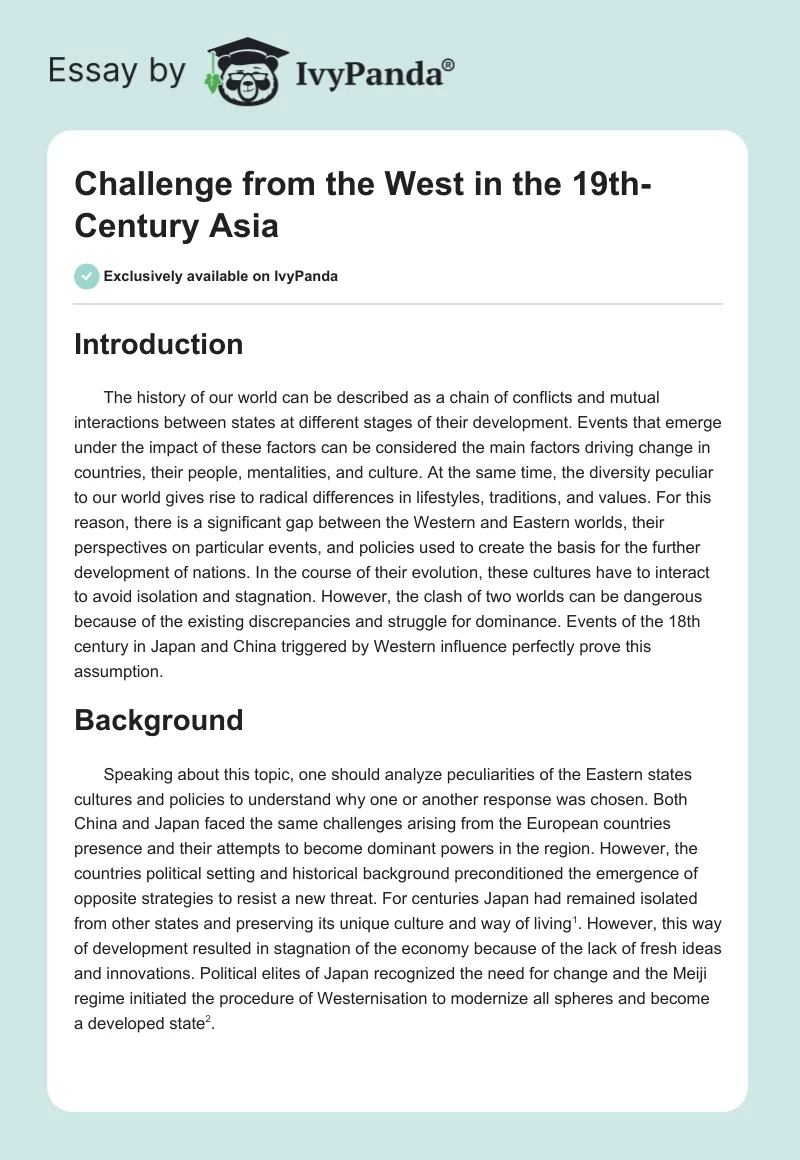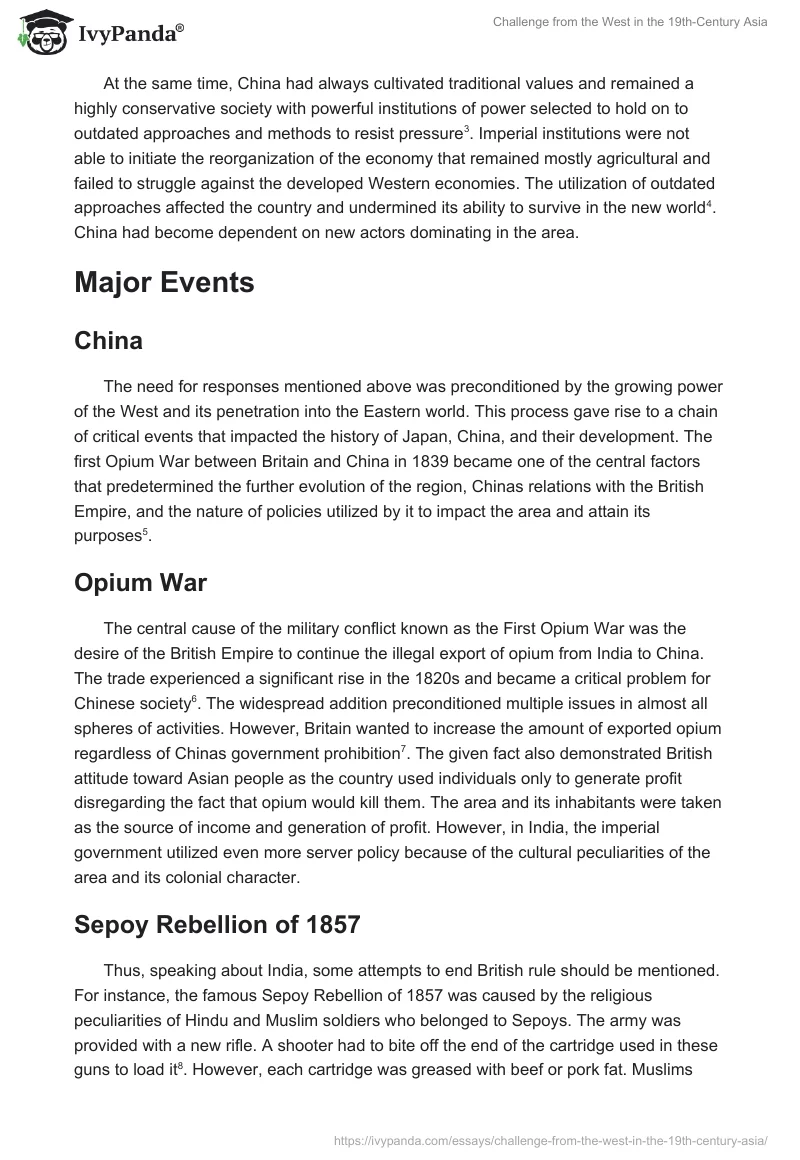Introduction
The history of our world can be described as a chain of conflicts and mutual interactions between states at different stages of their development. Events that emerge under the impact of these factors can be considered the main factors driving change in countries, their people, mentalities, and culture. At the same time, the diversity peculiar to our world gives rise to radical differences in lifestyles, traditions, and values. For this reason, there is a significant gap between the Western and Eastern worlds, their perspectives on particular events, and policies used to create the basis for the further development of nations. In the course of their evolution, these cultures have to interact to avoid isolation and stagnation. However, the clash of two worlds can be dangerous because of the existing discrepancies and struggle for dominance. Events of the 18th century in Japan and China triggered by Western influence perfectly prove this assumption.
Background
Speaking about this topic, one should analyze peculiarities of the Eastern states cultures and policies to understand why one or another response was chosen. Both China and Japan faced the same challenges arising from the European countries presence and their attempts to become dominant powers in the region. However, the countries political setting and historical background preconditioned the emergence of opposite strategies to resist a new threat. For centuries Japan had remained isolated from other states and preserving its unique culture and way of living. However, this way of development resulted in stagnation of the economy because of the lack of fresh ideas and innovations. Political elites of Japan recognized the need for change and the Meiji regime initiated the procedure of Westernisation to modernize all spheres and become a developed state.
At the same time, China had always cultivated traditional values and remained a highly conservative society with powerful institutions of power selected to hold on to outdated approaches and methods to resist pressure. Imperial institutions were not able to initiate the reorganization of the economy that remained mostly agricultural and failed to struggle against the developed Western economies. The utilization of outdated approaches affected the country and undermined its ability to survive in the new world. China had become dependent on new actors dominating in the area.
Major Events
China
The need for responses mentioned above was preconditioned by the growing power of the West and its penetration into the Eastern world. This process gave rise to a chain of critical events that impacted the history of Japan, China, and their development. The first Opium War between Britain and China in 1839 became one of the central factors that predetermined the further evolution of the region, Chinas relations with the British Empire, and the nature of policies utilized by it to impact the area and attain its purposes.
Opium War
The central cause of the military conflict known as the First Opium War was the desire of the British Empire to continue the illegal export of opium from India to China. The trade experienced a significant rise in the 1820s and became a critical problem for Chinese society. The widespread addition preconditioned multiple issues in almost all spheres of activities. However, Britain wanted to increase the amount of exported opium regardless of Chinas government prohibition. The given fact also demonstrated British attitude toward Asian people as the country used individuals only to generate profit disregarding the fact that opium would kill them. The area and its inhabitants were taken as the source of income and generation of profit. However, in India, the imperial government utilized even more server policy because of the cultural peculiarities of the area and its colonial character.
Sepoy Rebellion of 1857
Thus, speaking about India, some attempts to end British rule should be mentioned. For instance, the famous Sepoy Rebellion of 1857 was caused by the religious peculiarities of Hindu and Muslim soldiers who belonged to Sepoys. The army was provided with a new rifle. A shooter had to bite off the end of the cartridge used in these guns to load it. However, each cartridge was greased with beef or pork fat. Muslims and Hindu refused to do this and were punished. It became the root cause for the rebellion that sized the whole of India and ended with the British victory and a new policy that was monitored directly by the parliament. For the next one hundred years, the land had remained the British colony.
Japan
Japan also experienced the power of the West and its presence. In 1853 the American delegation arrived at the state which meant that it had to open its ports for foreign agents and provide new opportunities to exert pressure. At the same time, in 1854 Japan had to allow American trade in the country under the impact of cannon boat diplomacy and the growing power of the USA. These events had an outstanding effect on the state and demonstrated the rulers inability to resist the foreign pressure and protect domestic interests. That is why in 1867 soon after the Americans arrival, 676-year shogun rule had come to its end.
Results
All these events had a great impact on Japan and China and significantly impacted the course of their evolution. The in-time recognition of the necessity to change and utilize experiences of powerful Western countries allow the Meiji regime to launch the process of mass industrialization, military technologies development, and their connection to the institutional structures that affected the society of that period. These radical shifts were called the Meiji Restoration, and they became a success for the Japanese economy and state. It helped the nation to avoid an inferior position and became one of the new imperial powers impacting international policy and relations.
For China, its desire to preserve traditional values and inability to recognize the need to learn from the Western barbarians had a catastrophic impact on future development. The country did nothing to resist the imperialistic intentions of Britain. The weak industry that rested on the agricultural sector failed to provide the resources needed to struggle. As a result, China was sectioned by the western powers to generate benefits and use the area as a raw-material base. For a long period, the state had remained under European influence. Only in the 20th century, the first attempts to resist pressure and gain independence preconditioned shifts in peoples mentalities and promoted the rise of new political movements.
Conclusion
Altogether, the clash of Eastern and Western countries gave rise to multiple events that shaped the history of China and Japan. They introduced various responses the efficiency of which altered; however, their main purpose was to resist the imperialistic pressure and protect the land from severe exploitation and transforming into a raw-materials base. Japan managed to succeed in this process by modernizing its economy while trying to preserve its traditional values China failed and became dependant on the British Empire.
Bibliography
Fu, Yan. “Excerpts from ‘Learning from the West’.” Web.
Guifen, Feng. “Excerpts from ‘On the Adoption of Western Learning.” Web.
Holcombe, Charles. A History of East Asia: From the Origins of Civilization to the Twenty-First Century. Cambridge: Cambridge University Press, 2017.
Ikegami, Eiko. “Shame and the Samurai: Institutions, Trustworthiness, and Autonomy in the Elite Honor Culture.”Social Research 70, no. 4 (2003): 1351-1378. Web.
Pearson. “Lin Zexu: Letter to Queen Victoria, 1839.” Web.


